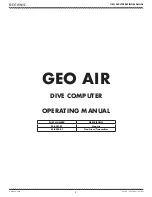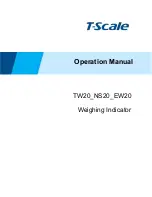
23
8. MAINTENANCE
8.1 Fault finding during commissioning
If a BA338C fails to function during commissioning
the following procedure should be followed:
Symptom
Cause
Check:
No display
Incorrect
wiring
Note:
Terminals 2, 4,
6 & 8 are
interconnected
within the
BA338C
That there is
between 10 and
28V on terminals
1 & 2 with terminal
1 positive.
Flow indicator
not rotating
No input
pulses,
incorrect input
terminals
used, or
incorrect type
of input
selected
That BA338C has
been calibrated for
the correct input.
That input signal
polarity is correct.
Flow indicator
rotating but
incorrect rate
display
Incorrect
calibration
Input below
clip-off
threshold
That rate scale
factor and
timebase are
correctly
programmed.
Clip-off threshold is
set correctly.
Unstable rate
display
Noisy pulse
input signal
Source of electrical
noise and try to
eliminate or
increase rate filter.
Correct rate
display but
incorrect total
display
Incorrect
calibration
Remote reset
switch
contacts
closed
That total scale
factor is correctly
programmed.
That ‘RESET’
annunciator is not
activated. If it is,
check reset wiring
and switch.
Unable to
enter
programme
mode
Incorrect
security code
That the correct
security code is
being used, or fit
security link in
override position.
See Fig 10
Clip-off does
not function
and 4/20mA
output is
constantly
3.5mA
Clip-off &
4/20mA have
been
automatically
reset to zero
following
change of rate
display
calibration
Re-enter required
clip-off and
4/20mA output
calibration.
Alarms do not
function
Alarms have
been disabled
following
calibration
change
Re-enable both
alarms.
8.2 Fault finding after commissioning
ENSURE PLANT SAFETY BEFORE
STARTING MAINTENANCE
Live maintenance is permitted on
intrinsically safe equipment installed in a
hazardous area, but only certified test
equipment should be used unless a gas
clearance certificate is available.
If a BA338C fails after it has been functioning
correctly, the following table may help to identify
the cause of the failure.
Symptom
Cause
Check:
No display
No power
supply.
That there is
between 10 and
28Von terminals 1
& 2.
Flow indicator
not rotating
No input
pulses
Output from
flowmeter
Wiring between
flowmeter and
BA338C
Flow indicator
rotating, but
rate display
indicates zero
and there is
no totalsiation
Input below
clip-off
threshold
Clip-off threshold
and if necessary
adjust.
Unstable rate
display
Noisy pulse
input signal
Source of electrical
noise and try to
eliminate, or
Increase rate filter.
If this procedure does not reveal the cause of the
fault, it is recommended that the instrument is
replaced.
8.3 Servicing
We recommend that faulty BA338C rate totalisers
are returned to BEKA associates or to our local
agent for repair.
8.4 Routine maintenance
The mechanical and electrical condition of the
instrument should be regularly checked. Initially
annual inspections are recommended, but the
inspection frequency should be adjusted to suit the
environmental conditions.
8.5 Guarantee
Instruments which fail within the guarantee period
should be returned to BEKA associates or our local
agent. It is helpful if a brief description of the fault
symptoms is provided.
8.6 Customer comments
BEKA associates is always pleased to receive
comments from customers about our products and
services. All communications are acknowledged
and whenever possible, suggestions are
implemented.
















































